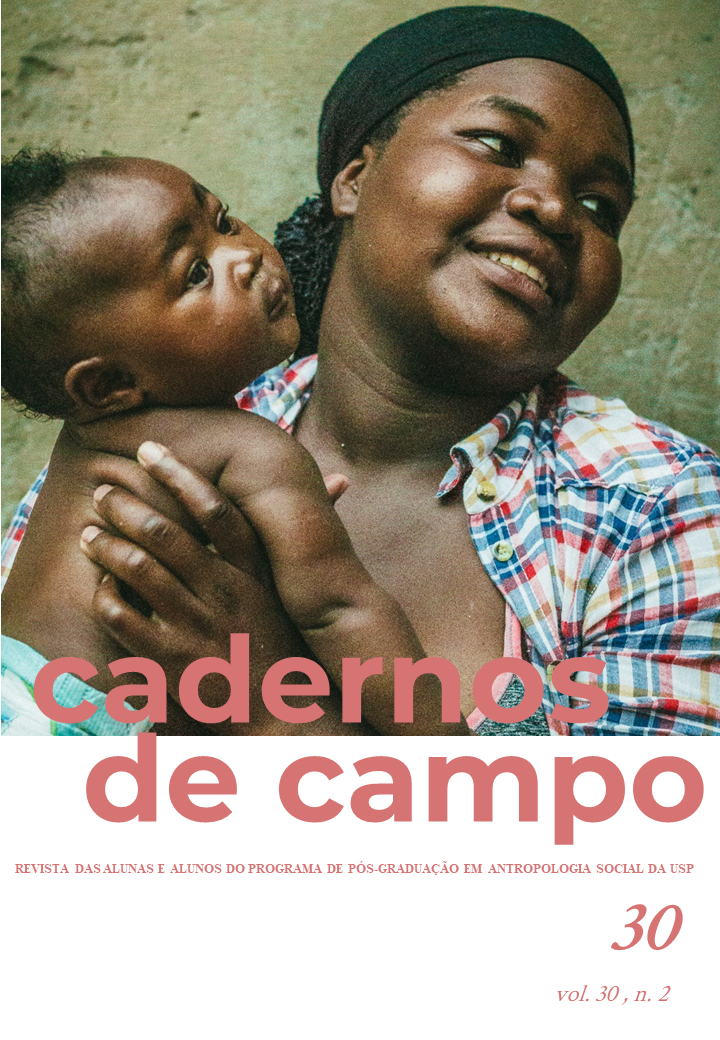Ce que la descente du hamac dit du genre chez les Wayãpi de Camopi
DOI:
https://doi.org/10.11606/issn.2316-9133.v30i2pe193360Abstract
The article concerns the experience of Wayãpi women in the commune of Camopi, in French Guiana, and deals specifically with the behavioral prescriptions and treatments that frame the moment of their first period. The bodies of young girls are then considered to be particularly sensitive to attacks from malicious entities. The ritual of descending from the hammock organized at the end of the confinement of the first period constitutes a parallel moment of reproduction, because the women of previous generations organize it in order to transmit to young girls physical and mental capacities such as motivation. at work and resistance to pain. However, our Wayãpi interlocutors highlight the equivalence between the ritual of the first menstruation for women and that of the birth of the first child for men, thus showing that the main capacities expected of adults are the same, whatever their gender. .
Downloads
References
ALES, Catherine. Pourquoi les Yanowamï ont-ils des filles? in Maurice Godelier & Michel Panoff (dir.). La Production du Corps, Editions des Archives Contemporaines, Overseas Publishers Association, pp.281-315, 1998.
BALÉE, William. Antiquity of traditional ethnobiological knowledge in Amazonia: the Tupí-Guaraní family and time. Ethnohistory, 47(2), 399-422, 2000.
BELAUNDE, Luisa Elvira. Viviendo bien: género y fertilidad entre los Airo-Pai de la Amazonía Peruana. Centro Amazónico de Antropología y Aplicación Práctica, CAAAP, 2001.
BELAUNDE, Luisa Elvira. El recuerdo de luna: género, sangre y memoria entre los pueblos amazónicos. Lima, Centro Amazónico de Antropología y Aplicación Práctica (CAAAP), 2005.
BELAUNDE, Luisa Elvira. Woxrexcüchiga: el ritual de la pubertad en el pueblo Ticuna. Perú, Ministerio de Cultura, 2016.
BELAUNDE, Luisa Elvira. El recuerdo de luna: género, sangre y memoria entre los pueblos amazónicos. Lima, Centro Amazónico de Antropología y Aplicación Práctica (CAAAP), 2005.
BELLIER, Irène. Le genre, la nature et les hommes chez les Mai Huna (Amazonie péruvienne). Journal des anthropologues, n.45, pp. 29-38, 1991.
BOURDIEU, Pierre. Les rites comme actes d'institution. Actes de la recherche en sciences sociales. Vol. 4. Rites et fétiches. pp. 58-63, 1982.Braconnier Olivia. 2021
BUCKLEY, Thomas ; GOTTLIEB, Alma. Blood magic. Berkeley, CA: University of California Press, 1988.
BUTLER, Judith. Trouble dans le genre. Pour un féminisme de la subversion. Paris: La Découverte, 2005 [1990].
DAVY, Damien. 2007. « “Vannerie et vanniers” : approche ethnologique d’une activité artisanale en Guyane française ». Thèse de doctorate en anthropologie.Université d’Orléans.
DAVY, Damien, TRITSCH Isabelle et Pierre GRENAND. Construction et restructuration territoriale chez les Wayãpi et Teko de la commune de Camopi, Guyane française. Confins , 16, 2012.
DESCOLA, Philippe. La Nature domestique: symbolisme et praxis dans l'écologie des Achuar. Les Editions de la MSH, 1986.
ERIKSON, Philippe. La griffe des aïeux: marquage du corps et démarquages ethniques chez les Matis d'Amazonie. Peeters Publishers, 1996.
GRENAND, Françoise. La longue attente ou la naissance à la vie dans une société Tupi (Wayampi du Haut Oyapock, Guyane Française). Bulletin de la Société Suisse des Américanistes, (48), 13-27, 1984.
GRENAND, Françoise. Et l’homme devint jaguar: l’univers imaginaire et quotidien des Indiens Wayãpi de Guyane. Paris: L’Harmattan. 1982.
GUZMÁN, María Antonieta. Para que la yuca beba nuestra sangre. Trabajo, género y parentesco en una comunidad quichua de la Amazonía ecuatoriana. Quito: Abya-Yala, 1997.
HECKLER, Serena. Tedium and creativity: the valorization of manioc cultivation and Piaroa women. Journal of the Royal Anthropological Institute, 10(2), 241-259, 2004.
HUGH-JONES, Stephen. La palma y las Pléyades. Bogotá : Ediciones Universidad Central, 2011 [1988].
KENSINGER, Kenneth. A body of knowledge, or, the body knows. In: Encedition. Philadelphia: University Museum, 1992.
LIMA, Tania. A parte do cauim: etnografia juruna. Ph.D. dissertation. Programa de Pós-Graduação em Antropologia Social, Museu Nacional, Universidade Federal do Rio de Janeiro, 1995.
McCALLUM, Cecilia. Aquisição de gênero e habilidades produtivas: o caso Kaxinawá. Revista Estudos Feministas, 157-157, 1999.
MENGET, Pierre. Temps de naître, temps d’être: la couvade. En: La fonction symbolique», M. Izard, P. Smith (éds.). Gallimard, Paris: 245-264, 1979.
METRAUX, Alfred. La religion des Tupinamba et ses rapports avec celle des autres tribus Tupi-Guarani. Presses Universitaires de France, « Quadrige », 2014 [1928]. 360p.
MORIN, Françoise ; SALADIN D’ANGLURE, Bernard. Excision féminine/incision masculine ou la construction sociale de la personne chez les shipibo-conibo d’Amazonie péruvienne, in Nicole-Claude Mathieu (éd.), Une maison sans fille est une maison morte. La personne et le genre en sociétés matrilinéaires et/ou uxorilocales. Paris, Maison des sciences de l’homme, 2007. 503 p.
RIVAL, Laura. Androgynous parents and guest children: the Huaorani couvade. Journal of the Royal Anthropological Institute, 619-642, 1998.
ROJAS ZOLEZZI, Enrique Carlos. Acerca del “saber cuándo hacer". El calendario Campa Asháninka y el ciclo anual de actividades. Anthropologica, 10 (10), 171-190, 1992.
SANTOS GRANERO, Fernando. The Power of Love: The Moral Use of Knowledge Amongst the Amuesha of Central Peru. London: Athlone Press, 1991.
STRATHERN, Marilyn. The Gender of the Gift: Problems with Women and Problems with Society in Melanesia. University of California Press, 1988.
THEVET, André. Les singularitez de la France antarctique, autrement nommée Amerique: & de plusieurs terres & isles decouvertes de nostre temps. Clos Bruneau, 1557.
TOLA, Florencia Carmen. Les conceptions du corps et de la personne dans un contexte amérindien. L’Harmattan, coll. « Recherches Amériques latines », Paris, 2009.
VILAÇA, Aparecida. Making kin out of others in Amazonia. Journal of the Royal Anthropological Institute, 8(2), 347-365, 2002.
VIVEIROS DE CASTRO, Eduardo. Araweté: os deuses canibais. Rio de Janeiro: ANPOCS/Jorge Zahar Editor, 1986.
Downloads
Published
Issue
Section
License
Copyright (c) 2021 Cadernos de Campo (São Paulo, 1991)

This work is licensed under a Creative Commons Attribution-NonCommercial-ShareAlike 4.0 International License.
I authorize Cadernos de Campo Journal of Anthropology to publish the work of my authorship/responsibility, as well as I take responsibility for the use of images, if accepted for publication.
I agree with this statement as an absolute expression of truth. On my behalf and on behalf of eventual co-authors I also take full responsibility for the material presented.
I attest to the unpublished nature of the work submitted





